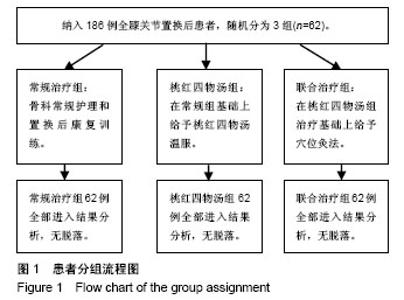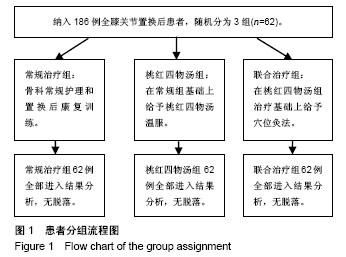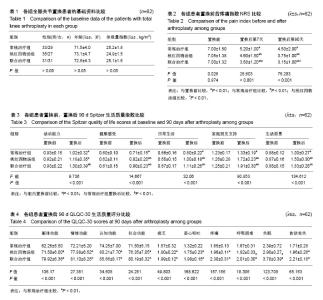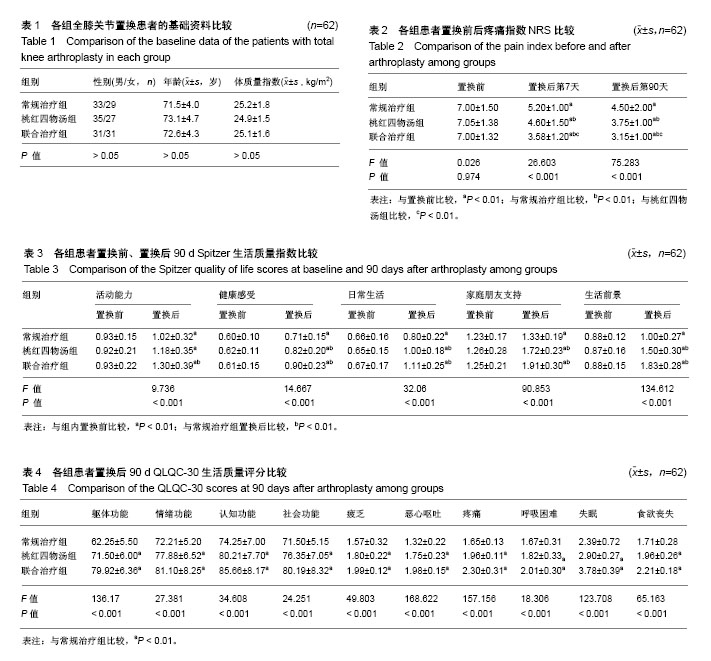| [1] Lim JB, Loh B, Chong HC,et al. History of previous knee surgery does not affect the clinical outcomes of primary total knee arthroplasty in an Asian population.Ann Transl Med. 2016;4(16):303.[2] 刘军,陈慧,甄平,等.人工关节假体的摩擦学研究进展[J].中国矫形外科杂志,2017,25(18):1670-1674.[3] Zheng CS, Xu XJ, Ye HZ, et al. Network pharmacology-based prediction of the multi-target capabilities of the compounds in Taohong Siwu decoction, and their application in osteoarthritis.Exp Ther Med.2013;6(1):125-132. [4] 陈慧,杜珊珊,梁晓燕,等.老年关节置换术后血栓的诊治及预防[J].中华老年多器官疾病杂志,2016,15(1):64-68.[5] Li RS, Li DY, Chen WN, et al.Taohong Siwu Decoction regulated functions of endothelial cells and treated arteriosclerosis obliterans: an experimental study.Zhongguo Zhong Xi Yi Jie He Za Zhi. 2014;34(2):191-196.[6] Li L, Yang N, Nin L, et al. Chinese herbal medicine formula tao hong si wu decoction protects against cerebral ischemia-reperfusion injury via PI3K/Akt and the Nrf2 signaling pathway. J Nat Med. 2015;69(1):76-85.[7] Sun J, Zhang BX, Yan SR, et al. Study on self-similarity of property combination mode of traditional Chinese medicines. Zhongguo Zhong Yao Za Zhi. 2014;39(13):2378-2381.[8] Liu L, Duan JA, Su SL, et al. Effect of different fractions of Taohong Siwu decoction on ADP-induced platelet aggregation and thrombin activity. Zhongguo Zhong Yao Za Zhi. 2016;41(4):716-721. [9] Li X, Li DY, Chen WN, et al. Effect of ASO blood stasis syndrome serum on vascular endothelial cell injury and regulation of Taohong Siwu Decoction on it. Zhongguo Zhong Xi Yi Jie He Za Zhi. 2015;35(11):1373-1377.[10] 施文佳,陈绍军,徐昭乐,等. 桃红四物汤治疗急性交叉韧带断裂膝关节肿痛35例[J]. 江西中医药,2018,49(1):43-45.[11] 尹书东,唐本夫,尹新生. 微创手术联合桃红四物汤加味治疗髋关节疾病55例临床观察[J]. 湖南中医杂志,2017,33(7):83-85.[12] 陈晓波,陈雷雷,洪郭驹,等. 桃红四物汤对激素性股骨头坏死兔股骨头微结构的影响及其机制[J]. 山东医药,2017,57(32):5-9.[13] 唐建军,董国良,黄晓蓉,等.桃红四物汤预防人工髋、膝关节置换术后DVT的临床观察[J]. 内蒙古中医药,2017,36(16):24-25.[14] 吴伟丽,蒋俊燕,余龙龙. 桃红四物汤熏蒸疗法治疗软组织挫伤临床观察[J]. 新中医,2017,49(4):47-49.[15] 孔军. 桃红四物汤防治髋关节置换术后静脉血栓气滞血瘀型30例[J]. 中医研究,2017,30(7):38-40.[16] 董根荣,陈龙,何斌,等.加味桃红四物汤对老年股骨转子间骨折股骨近端防旋髓内钉内固定术围手术期隐性失血的影响[J]. 中医正骨,2017,29(9):12-14+22.[17] 莫元森,代亮,胡永春,等. 桃红四物汤预防股骨骨折术后深静脉血栓效果观察[J]. 实用中医药杂志,2017,33(10):1127-1128.[18] Liu L, Duan JA, Su SL, et al. Siwu series decoctions for treating primary dysmenorrea of gynecology blood stasis syndrome--research progress of Taohong Siwu decoction. Zhongguo Zhong Yao Za Zhi. 2015;40(5):814-821.[19] Xi S, Shi M, Jiang X, et al. The effects of Tao-Hong-Si-Wu on hepatic necroinflammatory activity and fibrosis in a murine model of chronic liver disease. J Ethnopharmacol. 2016;180: 28-36. [20] 丁利刚,李颖,马明远,等.中西药联合用于老年肥胖全髋关节置换术后的镇痛效果研究[J].世界中医药,2013,8(10):1187-1192.[21] 周林,杨小莉,李乃戈,等.中药在髋关节置换术后止痛的应用[J].局解手术学杂志,2013,22(4):393-395.[22] 葛继文,杨伟伟.早期康复联合中药熏蒸对髋关节置换术后ADL 的影响[J].浙江中医杂志,2013,47(11):811-812.[23] 俸道荣,盘晓荣,覃一玨. 桃红四物汤和高压氧对膝关节骨性关节炎患者血清TNF-α及IL-6含量的影响[J]. 中西医结合心血管病电子杂志,2017,5(30):171-172.[24] 齐振熙,康靖东. 桃红四物汤干预激素性股骨头缺血坏死组织局部微血管密度的变化[J]. 中国组织工程研究与临床康复, 2009, 13(11):2040-2043.[25] 李树强,于涛,齐振熙. 桃红四物汤对激素诱导骨髓间充质干细胞成脂分化的干预作用[J]. 中国组织工程研究与临床康复, 2010,14(19):3539-3543.[26] 赵利民. 中西药物预防人工髋关节假体置换后下肢深静脉血栓形成[J]. 中国组织工程研究,2013,17(22):4130-4136.[27] 刘冬,谭秦莉,李玉宝,等.桃红四物汤治疗原发性痛经实验研究[J].安徽中医学院学报,2009,28(2):46-48.[28] 童培建,何帮剑,黄余亮.中医药疗法在全膝关节置换术围术期的干预作用[J].中医正骨,2013,25(1):8-10.[29] 孙洁,仲大奎,魏惠芳,等.艾灸不同穴位对慢性炎症痛模型大鼠心理行为改变的实验观察[J].吉林中医药,2012,32(1):61-65.[30] Zhang X, Li P, Hua Y, et al. Urinary metabolomics study the mechanism of Taohong Siwu Decoction intervention in acute blood stasis model rats based on liquid chromatography coupled to quadrupole time-of-flight mass spectrometry. J Chromatogr B Analyt Technol Biomed Life Sci. 2018; 1074-1075: 51-60. [31] 殷韶健. 桃红四物汤加减对老年髋部骨折术后下肢深静脉血栓形成的预防效果评价[J]. 四川中医,2017,35(12):190-193.[32] 王晓彤,林海雄,肖志勋,等. 桃红四物汤加减辅助治疗外伤性骨折临床疗效和安全性的系统评价[J]. 中国药房, 2017,28(36): 5106-5110.[33] 吴迪,鞠洋,张力洋. 桃红四物汤联合应力刺激治疗下肢骨干粉碎性骨折的疗效观察[J]. 中国医药指南,2017,15(34):169-170.[34] 林智军,李玉茂,谢晓勇,等.桃红四物汤加减治疗对气滞血瘀型股骨头坏死骨修复及血液流变学的影响[J]. 世界中医药, 2018, 13(1):105-108.[35] 徐增瑞. 桃红四物汤治疗早期外伤性骨折临床研究[J]. 亚太传统医药,2017,13(23):142-143.[36] 韩振华,康乐,李向阳,等. 桃红四物汤加减联合针灸治疗早期股骨头坏死疗效观察[J]. 陕西中医,2017,38(12):1736-1738.[37] 苏进益,何文全. 桃红四物汤治疗跟骨骨折术后患者30例疗效观察[J]. 浙江中医杂志,2017,52(11):819.[38] 刘立,段金廒,宿树兰,等.用于妇科血瘀证痛经的四物汤类方—桃红四物汤的研究进展[J].中国中药杂志,2015,40(5): 814-821.[39] Gu ZM, Lin SB, Liu CJ,et al.Effect of Taohong Qinlian Decoction on HMGB1 in septic rat cardiac muscle. Zhong guo Zhong Xi Yi Jie He Za Zhi. 2016;36(4):445-448.[40] 刘立,段金廒,华永庆,等.桃红四物汤用于原发性痛经的整合效应评价研究[J].中国中药杂志, 2012,37 (21):3275-3281.[41] 杨帅,任晓暄,赵雅芳,等.电针“百会”“足三里”穴对慢性内脏痛模型大鼠行为及组织中5-HT水平的影响[J].吉林中医药, 2013, 33(4):400-402. |



